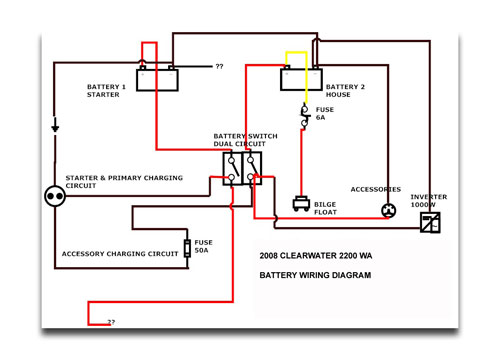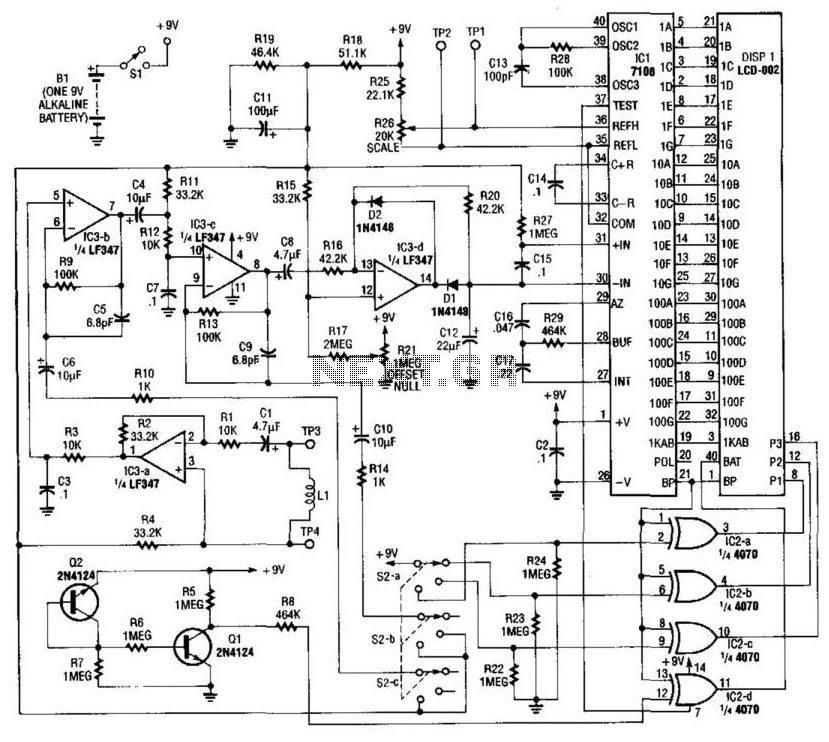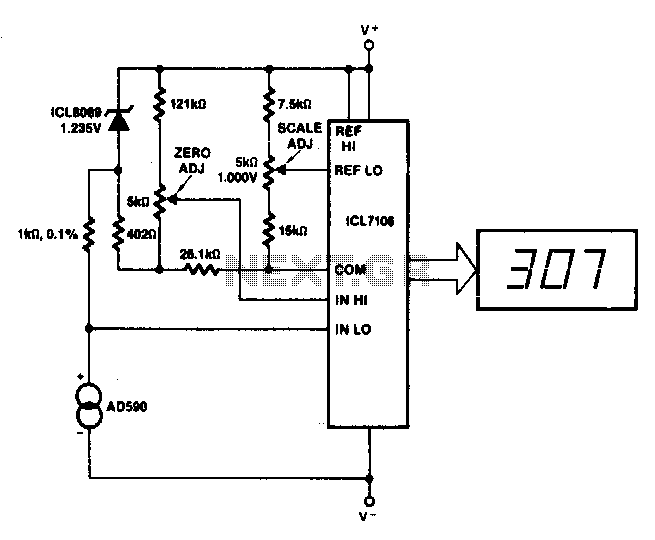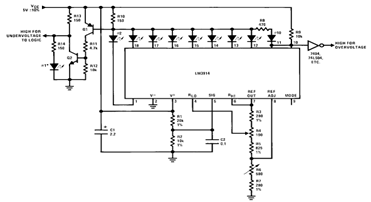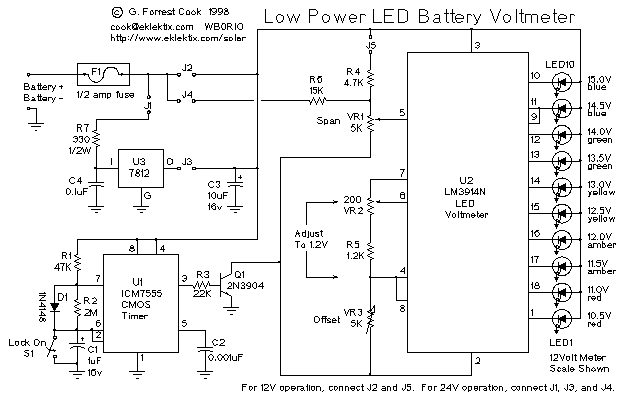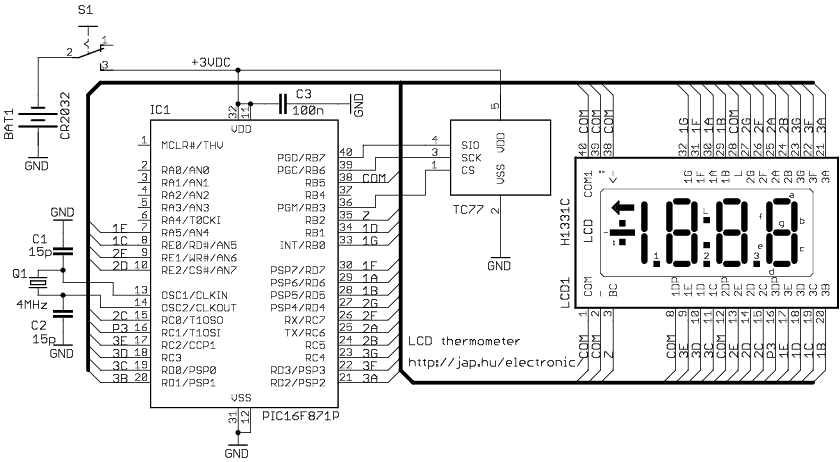
Build Your Own Gauss Meter
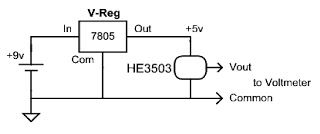
Have you ever wanted to determine the strength of a magnet, observe how the magnetic field strength changes with distance or temperature, or evaluate the effectiveness of a shield placed in front of the magnet? Voltmeters are relatively inexpensive and readily available, but where can one purchase a Gaussmeter (also known as a magnetometer)? A hand-held Gaussmeter has been constructed for measuring the polarity and strength of a magnetic field. It utilizes a linear Hall effect sensor along with operational amplifiers and resistors sourced from a local electronics retailer. When a magnet is positioned near the Hall device, the output voltage varies: if the magnet's South pole is facing the sensor, the voltage increases, whereas if the North pole is facing, the voltage decreases. This voltage reading is referred to as V1. The sensitivity of the Hall device is specified as 2.50 mV/G in the manufacturer's datasheet, denoted as k. Consequently, the Magnetic Flux Density being measured from the magnet can be calculated using this information. It is straightforward to create a plot using spreadsheet software like Excel to avoid constant calculations. While taking measurements, one can simply record the output voltage and perform the calculations later. It is important to note that pickup covers influence the magnetic field in which the strings vibrate, with a significant drop in Gauss observed over the slug polepieces. The adjustable polepieces exhibit considerably greater magnetism compared to those that are covered.
A hand-held Gaussmeter is an essential tool for anyone interested in the study of magnetic fields. The design incorporates a linear Hall effect sensor, which is sensitive to magnetic fields and provides a measurable output voltage that corresponds to the strength of the field. The operational amplifiers are used to amplify the output signal from the Hall sensor, ensuring that small changes in magnetic field strength can be accurately detected and displayed.
The construction of the Gaussmeter involves connecting the Hall effect sensor to an op-amp circuit, which then drives an analog output that can be read on a voltmeter or displayed on an LCD screen. The sensitivity factor, k, allows for the conversion of the measured voltage into a magnetic flux density value, facilitating quantitative analysis of the magnetic field strength.
In practical applications, users can place the Gaussmeter at varying distances from the magnet to observe how the magnetic field strength diminishes with distance, following the inverse square law. Additionally, varying the temperature of the magnet can yield insights into how thermal conditions affect magnetic properties. The effects of shielding materials can also be evaluated by positioning different materials in front of the magnet and measuring the resultant changes in the magnetic field strength.
For data analysis, users can log the voltage readings and later input them into a software program to generate graphs that visually represent the relationship between the distance from the magnet, the temperature, and the corresponding magnetic field strength. This method simplifies the process of understanding magnetic field behavior and allows for more effective experimentation and research.
Overall, the hand-held Gaussmeter serves as a versatile and user-friendly device for both educational and professional applications in the field of magnetism, enabling users to explore and quantify magnetic phenomena with ease.Have you ever wanted to find out how strong a magnet really was, or how the strength of the magnetic field varied as you changed the distance from the magnet or the temperature of the magnet, or how well a shield placed in front of the magnet worked Voltmeters are fairly inexpensive and easy to find, but where do you purchase a Gaussmeter (also k nown as a magnetometer). I built a hand-held Gaussmeter for measuring the polarity and strength of a magnetic field. It uses a linear Hall effect device and some op-amps and resistors and things from Radio Shack. Now, with a magnet near the Hall device, you will see the output voltage change. If it is a South pole, the voltage will increase. If it is a North pole, the voltage will decrease. Call this voltage reading V1. We will say that the sensitivity of the Hall device is 2. 50mV/G as found on their data-sheet. Call this k. Therefore, the Magnetic Flux Density you are measuring from that magnet can be calculated as: See how easy that is You can make your own plot using Excel so you don`t have to calculate all the time. If you`re taking measurements, just write down the output voltage and do the calculations later. Pickup covers do affect the magnetic field that the strings vibrate in. The most pronounced drop in gauss is over the slug polepieces. The adjustable polepieces have significantly more power than covered ones. 🔗 External reference
A hand-held Gaussmeter is an essential tool for anyone interested in the study of magnetic fields. The design incorporates a linear Hall effect sensor, which is sensitive to magnetic fields and provides a measurable output voltage that corresponds to the strength of the field. The operational amplifiers are used to amplify the output signal from the Hall sensor, ensuring that small changes in magnetic field strength can be accurately detected and displayed.
The construction of the Gaussmeter involves connecting the Hall effect sensor to an op-amp circuit, which then drives an analog output that can be read on a voltmeter or displayed on an LCD screen. The sensitivity factor, k, allows for the conversion of the measured voltage into a magnetic flux density value, facilitating quantitative analysis of the magnetic field strength.
In practical applications, users can place the Gaussmeter at varying distances from the magnet to observe how the magnetic field strength diminishes with distance, following the inverse square law. Additionally, varying the temperature of the magnet can yield insights into how thermal conditions affect magnetic properties. The effects of shielding materials can also be evaluated by positioning different materials in front of the magnet and measuring the resultant changes in the magnetic field strength.
For data analysis, users can log the voltage readings and later input them into a software program to generate graphs that visually represent the relationship between the distance from the magnet, the temperature, and the corresponding magnetic field strength. This method simplifies the process of understanding magnetic field behavior and allows for more effective experimentation and research.
Overall, the hand-held Gaussmeter serves as a versatile and user-friendly device for both educational and professional applications in the field of magnetism, enabling users to explore and quantify magnetic phenomena with ease.Have you ever wanted to find out how strong a magnet really was, or how the strength of the magnetic field varied as you changed the distance from the magnet or the temperature of the magnet, or how well a shield placed in front of the magnet worked Voltmeters are fairly inexpensive and easy to find, but where do you purchase a Gaussmeter (also k nown as a magnetometer). I built a hand-held Gaussmeter for measuring the polarity and strength of a magnetic field. It uses a linear Hall effect device and some op-amps and resistors and things from Radio Shack. Now, with a magnet near the Hall device, you will see the output voltage change. If it is a South pole, the voltage will increase. If it is a North pole, the voltage will decrease. Call this voltage reading V1. We will say that the sensitivity of the Hall device is 2. 50mV/G as found on their data-sheet. Call this k. Therefore, the Magnetic Flux Density you are measuring from that magnet can be calculated as: See how easy that is You can make your own plot using Excel so you don`t have to calculate all the time. If you`re taking measurements, just write down the output voltage and do the calculations later. Pickup covers do affect the magnetic field that the strings vibrate in. The most pronounced drop in gauss is over the slug polepieces. The adjustable polepieces have significantly more power than covered ones. 🔗 External reference
